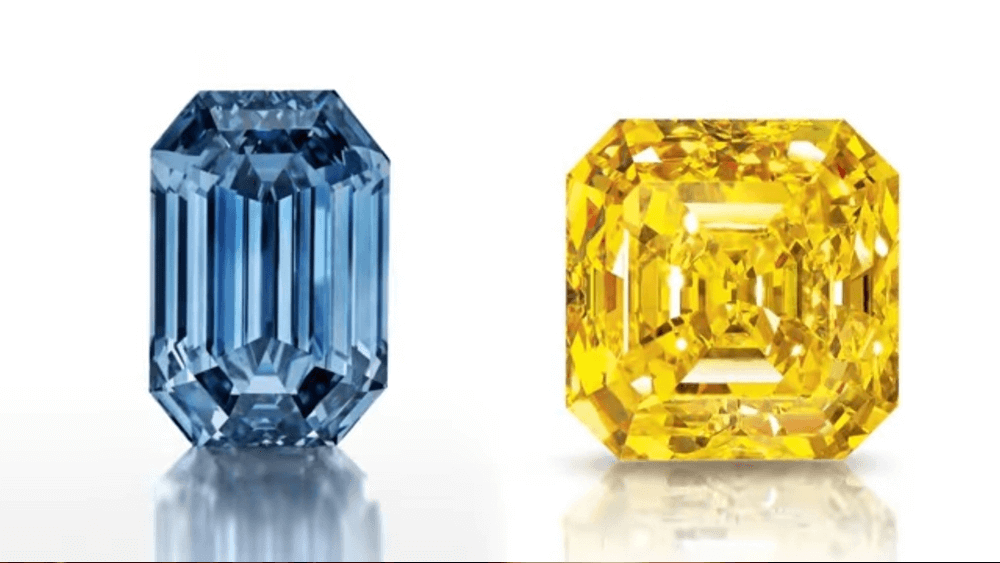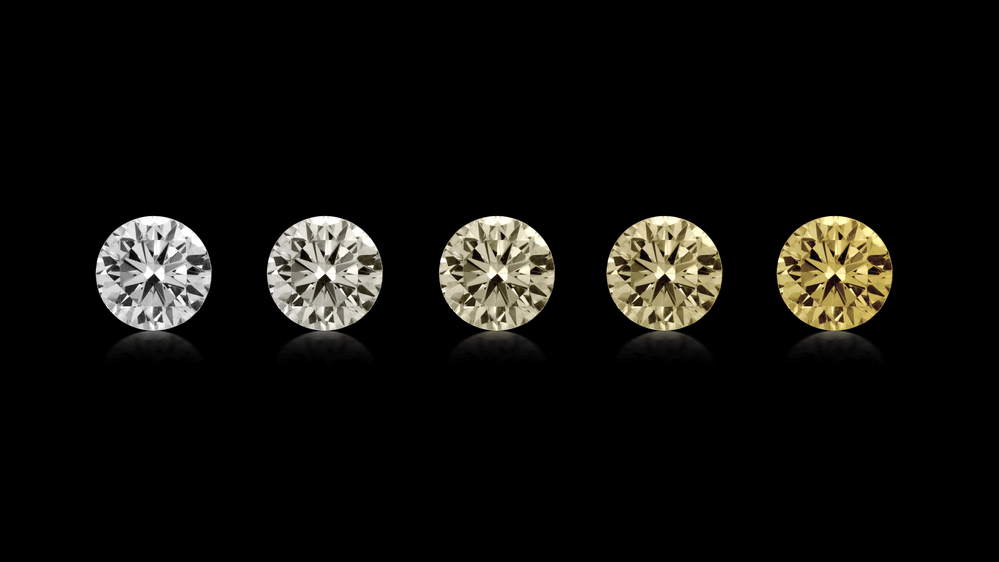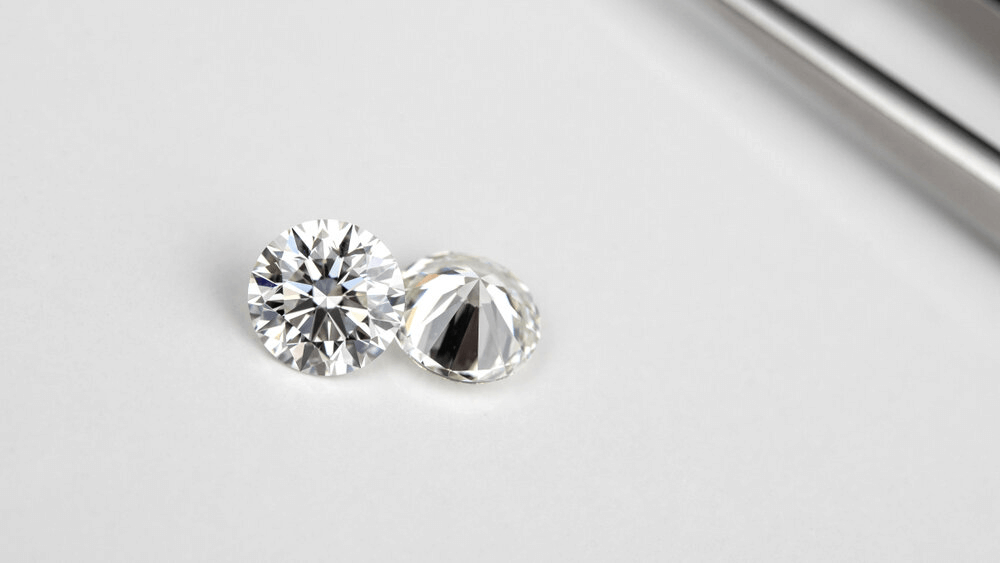Choosing F Color Diamonds: A Complete Guide

By Gary A.

Edited by Olivia H.
Published Sep 2, 2021
Edited on Dec 17, 2024
When it comes to finding that perfect balance between brilliance and affordability, an F Color Diamond offers a near-colorless shine that’s almost indistinguishable from the highest grades – but is it the right choice for you?

Navigate This Guide:
- 7 Quick Tips for Buying an F Color Diamond Engagement Ring
- Introduction
- The Basics to F Color Diamonds
- The GIA Scale and F-Color Ranking
- F-Color Diamond Price Point Analysis
- The Importance of Clarity and Cut
- Our Expert Take
- 7 FAQs
Before we dive deeper into the specifics, here are some practical tips to help guide your decision-making process:
7 Quick Tips for Buying an F Color Diamond Engagement Ring
When purchasing an F-color diamond engagement ring, paying close attention to certain aspects can ensure you get the best value and appearance. Here are practical tips to guide you through the process:
- Tip 1: Assessing the Diamond’s Color in Natural Light: Lighting can significantly impact how the color of a diamond appears. To accurately assess an F-color diamond, view it in natural daylight. What to Do: Examine the diamond outdoors or near a window. Ensure the lighting is not too dim or overly bright, as artificial lighting can mask subtle color nuances.
- Tip 2: Comparing with Other Color Grades: Understanding the subtle differences between F-color and other grades helps in making an informed decision. What to Do: Compare the F-color diamond side by side with diamonds of other color grades (like G, H, or even D and E). This comparison will help you appreciate the F-color’s near-colorless quality and see if the premium for an F-color is justifiable to you. When comparing put the diamond on its table for a side view and use a white background.
- Tip 3: Considering the Metal of the Ring Setting: The metal color of the ring setting can influence the perceived color of the diamond. What to Do: Choose a setting that complements the F-color diamond. White gold and platinum are excellent choices as they enhance the diamond’s colorless appearance. Be cautious with yellow or rose gold, as they may impart a slight hue to the diamond.
- Tip 4: Checking for Fluorescence: Fluorescence can affect the appearance of a diamond under certain lighting conditions. What to Do: Ask if the diamond has fluorescence. For F-color diamonds, strong fluorescence might not be desirable as it can make the diamond appear hazy or oily, especially in sunlight. Prefer a diamond with none to medium fluorescence.
- Tip 5: Balancing the 4Cs: Color shouldn’t be the only factor; the Cut, Clarity, and Carat weight also play a crucial role. What to Do: Prioritize a well-cut diamond as it greatly influences the sparkle and brilliance. Don’t compromise on cut quality for a higher color grade. Ensure the clarity level is such that inclusions aren’t visible to the naked eye.
- Tip 6: Inspecting Under Magnification: Magnification can reveal subtle aspects of the diamond’s color that are not visible to the naked eye. What to Do: Use a jeweler’s loupe to closely inspect the diamond. Look for any hints of color inconsistencies, especially around the edges and facets.
- Tip 7: Evaluating Diamond Shape and Size: The shape and size of the diamond can influence how color is perceived. What to Do: Certain shapes like round, oval, and marquise hide color better than others like emerald or asscher cuts. Larger diamonds can show color more easily, so be more discerning with diamonds over 1 carat.
Now that you’ve got these practical tips, use Jeweler AI below to find the perfect engagement ring that suits your style and budget:
Introduction
Whether you’ve already made yourself busy pouring over our guides to The Four Cs recently, or you’re new to the phrase ‘F-Color Diamond’, the most important thing right now is that you find your bearings in this category before making any big commitments.
If quality was the only thing that mattered, and the only diamonds worth buying were those that had been graded at the very top of every GIA Scale out there, then your job (and, of course, ours) would be much, much easier. The only diamonds for sale would be those considered virtually perfect by gemologists, and the only people able to invest in diamonds would be those capable of paying that premium price that comes with perfection.
That would leave most of us on the sidelines – and mean that countless beautiful diamonds were being overlooked simply because they’re not perfect.
F-Color diamonds are pretty close to being considered perfect – and we’ll tell you more about that below – but they’re also a less-than-ideal choice for many shoppers looking to find the ideal diamond for their engagement ring. Confused? Don’t be – here’s why…
The Basics to F Color Diamonds
First off, the basics. From the meaning an F-Color Grade holds in the objective worlds of the laboratory and the diamond market, to what an F-Color Grade means for you and your engagement ring, here is the lowdown on diamonds that boast an F Grade in their GIA Report.
A color F diamond is considered practically colorless – or, in other words, almost free from the yellow or brown tint that many diamonds naturally acquire as they develop underground. And, in all likelihood, you won’t be able to detect any discoloration at all when looking at an F-Color diamond.
The GIA Scale and F Color Ranking
At this stage, the most important thing to keep in mind is that the Gemological Institute of America’s color scale runs from D to Z, meaning that the clearest diamonds are graded by the GIA as D Color Diamonds.
The difference between any consecutive color grades is very slight, and only when you get approximately halfway down the scale (around a grade K) will you start to notice a yellowish tint to the diamonds. For this reason, it’s more important that you get used to the broader groups used within this scale.
For instance, any gemstone that is graded from D to F is regarded as ‘colorless’, with only the most minor differences between, say, a D diamond and an E diamond – and too minor to be detected under normal lighting, and without the expert eye of the gemologist.
After that, we have the diamond grades grouped under the category ‘Near Colorless’. This includes grades G, H, I and J, which are followed by ‘Faint Yellow’, ‘Very Light Yellow’ and ‘Light Yellow’ groupings down to Z color diamonds. Fancy colored diamonds – whether blue, red, pink, yellow or green – are graded according to a separate scale, with this one just being used for clear diamonds.
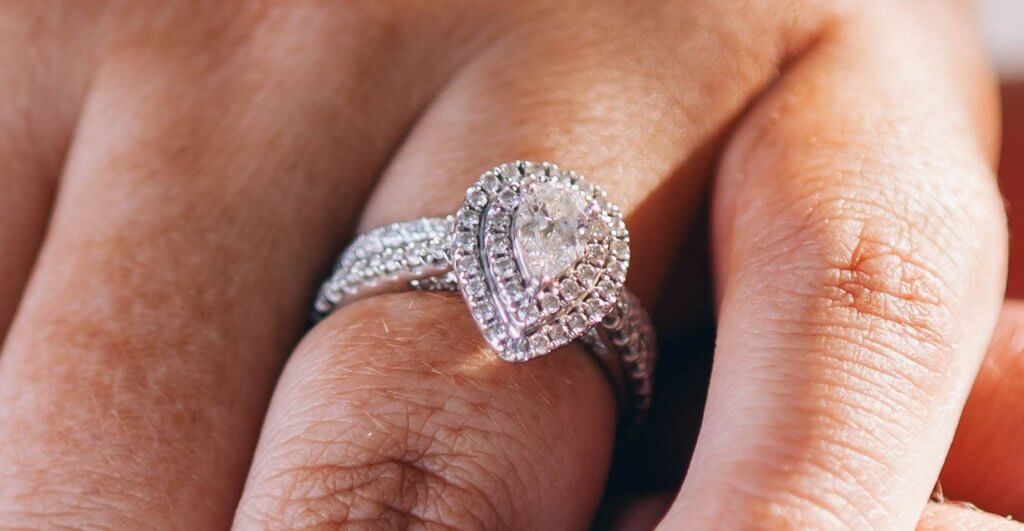
Understanding Where F Color Diamonds Stand in the GIA Grading System
In terms of diamond quality, a stone graded with an F-Color is very close to the ‘ideal’. However, in terms of investing, an F Diamond may not be your ideal choice, for many reasons.
The F Diamond’s proximity to a D grade gives it a certain amount of prestige on the diamond market – and, with that, a hefty price tag. Just as VVS diamonds are pretty coveted by collectors, for those who spend their lives collecting the very best quality diamonds they can find, an F-Color is one of the most coveted grades, and it could mean that two otherwise similar diamonds differ in price by thousands of dollars.
Still, as we mentioned above, F belongs to the color group known as colorless. True, it’s not as colorless as a D color diamond but, in an everyday scenario (and not a diamond testing lab), you’re not going to be able to detect any real difference. It won’t show any signs of yellowing.
What does this mean for you? It means that, unless the sky is the limit for your budget, you’re going to waste a good chunk of your investment if you decide not to settle for anything less than an F-Color Diamond. The group of ‘near colorless’ diamonds we mentioned above (ranging from G Color Diamonds to J Color Diamonds) feature so little color that you’re unlikely to ever notice a difference, and any minor yellowing will evade you.
In essence, investing in an F-Color Diamond means investing in the color grade itself, rather than the visual impact of the diamond. Since, even though an F-Color Diamond will look truly beautiful, that beauty is still available for a lower cost, those leftover funds can be invested into the clarity or carat weight of the diamond instead.
F Color Diamond Price Point Analysis
As with any aspect of a diamond, it all boils down to price in the end. Making a wise investment is a process of many parts since all of the four Cs impact the diamond’s appearance in their own way, and neglecting one means ending up with something too small or too flawed to have the impact you’re looking for.
Why F Color Diamonds Are Rarely Worth it
We’d never say that F-Color Diamonds should never find their way into engagement rings, but that, if you’re worried that you’re getting pretty close to the edge in terms of budget, you can certainly afford to lose three or four color grades before any discoloration starts to show.
If your heart has been stolen by a diamond that bears the right cut, quality, and size, and it just so happens to be an F-Color, there’s nothing inherently wrong with picking it.
But, if you’re feeling compelled towards F-Color simply because there’s a little voice in the back of your head that’s resisting an objectively ‘lower’ quality, try to shake it off before you begin your search on our online store.
Comparing F and G Color Diamonds
Unless you’re an expert jeweler or gemologist with the right lighting and equipment to detect the very minor differences that separate one diamond grade from the next, any attempt to differentiate between the two would be pure guesswork.
If you were holding this F-VS2 Emerald Diamond in one hand, and this G-VS2 Emerald Diamond in your other hand, then we’re willing to bet you wouldn’t be able to notice a difference – even though, according to their unique GIA Diamond Reports, there is one.
Similarly, if you were to make two identical rings using two diamonds that were equal in every respect except color – with one being an F-Color and one being a G Color – then you’d probably have a hard time figuring out which was more valuable. If the difference was much more significant –say, an F Diamond and a faintly yellow L Color Diamond, you would.
This is why we recommend looking at the color grades in terms of those separate groupings, rather than the individual letters. The most major difference falls between J and K Diamonds, which, as we mentioned above, happen to fall on the cusp of ‘Near Colorless’ and ‘Faint Yellow’, and that’s why we always recommend going no lower than J.
For you, the most discernible difference between F and G Color diamonds will be price. For those two diamonds, provided they are pretty much the same in terms of Cut, Clarity and Carat, the price difference could amount to a few hundred dollars – all of which will be paying for the prestige of owning an F-Color Diamond, rather than for the visual impact.
After all, you wouldn’t be able to tell the difference between a 1-carat or a 1.1-carat diamond, just as you would struggle to know whether you were looking at a diamond with a clarity rating of VVS2 or VS1. Provided you stick to the higher end, and ensure you are always above a certain level for quality, you don’t need to aim for the very best money can buy. It might carry a certain amount of prestige, but that’s about it.
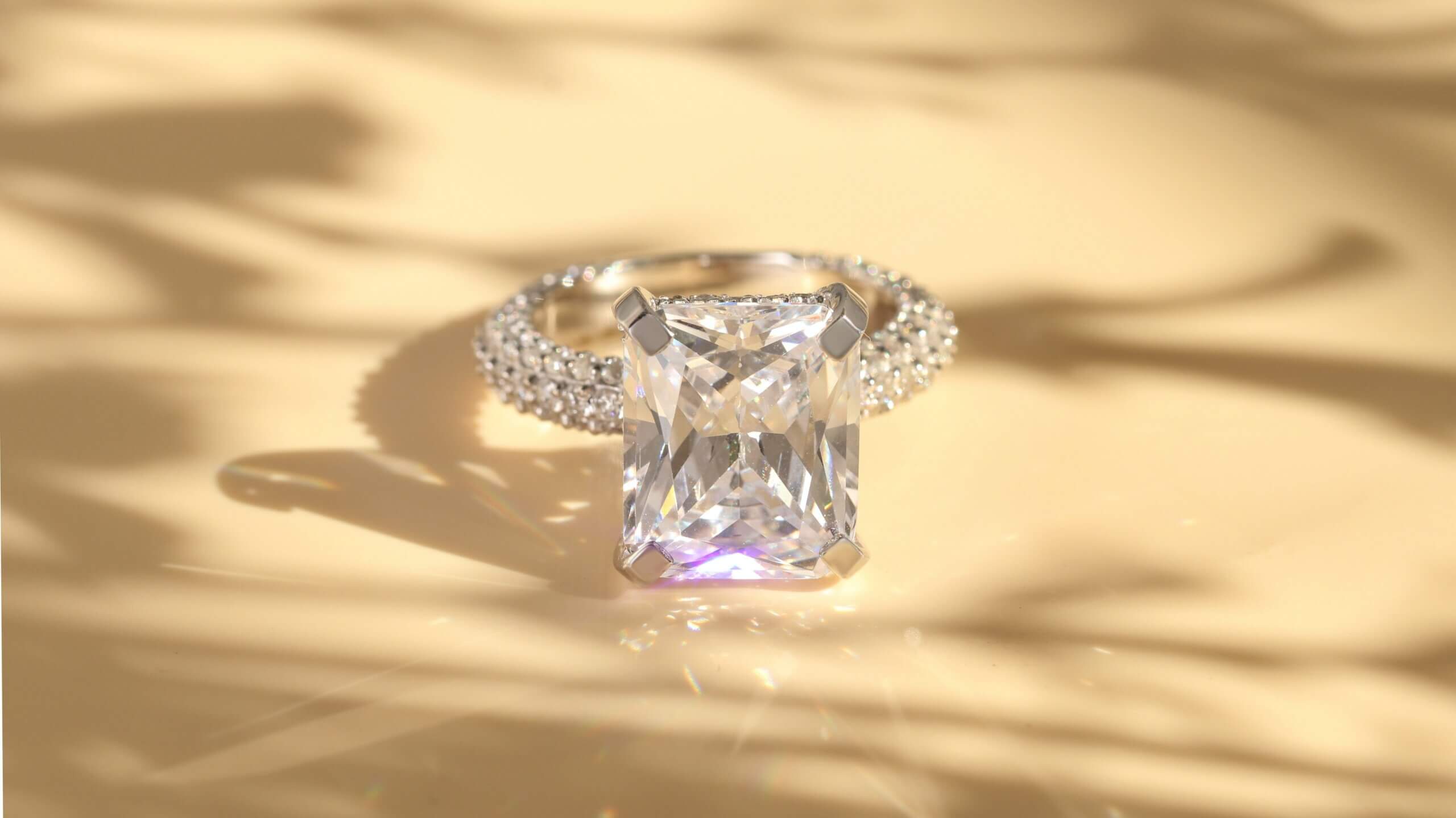
The Importance of Clarity and Cut
Quite a lot of the time, color and clarity are weighed up against one another – more often than color is weighed up against carat or cut. This is because color and clarity refer to the negative characteristics that are found in diamonds since both discoloration and inclusions are considered flaws that ought to be avoided as much as possible. Where these flaws are kept to a minimum, the price goes up significantly.
So, when buying a diamond, you need to find a good balance between investing in color and investing in clarity.
Is an F SI1 Diamond Good?
It’s not exactly ideal. While an F-Color Diamond will mean the diamond looks free from any yellowing, it would be better to meet in the middle with, say, a G VS2 diamond, which stands a better chance of being eye-clean.
Remember what we said about how the difference between an F-Color Diamond and, say, a G or H Colored Diamond will be far more significant for your wallet than it will be for your naked eye? Well, this is where that notion comes into play.
As the name suggests, an SI1 diamond features slight inclusions. While this isn’t necessarily a dealbreaker, we would always recommend that buyers aim for a slightly higher clarity grade. A VS1 diamond, for instance, will offer eye-cleanliness – or, in other words, the appearance of near-flawlessness without the price tag.
The naked eye simply can’t pick up on flaws that subtle. This is a great benefit to shoppers, particularly because it works both ways: we can’t tell the difference between VS and VVS, meaning we can save money by opting for VVS, just as we can’t tell the difference between F Diamonds and H Diamonds, meaning we can save a little extra there, too.
F-S1 Diamonds can look beautiful. This 1.51 Carat F-SI1 Princess Diamond is a prime example of a diamond’s natural tendency toward beauty, even when it’s technically flawed.
Still, as far as balancing your investment goes, there are better ways to do it that would enable you to get a diamond much closer to eye-cleanliness.
Is an F VVS Diamond Good?
Yes and no. An F-Color VVS Diamond will appear flawless. Any discoloration or inclusions will go unnoticed, and you can invest with full confidence in the eye-cleanliness of your diamond. Still, you can get that same level of confidence from a diamond that has been graded slightly lower in terms of color and clarity, meaning more money is left over for buying a diamond with larger carat weight.
Of course, you may be happy with a slightly smaller diamond. In this case, there’s nothing wrong with investing in an F-VVS Diamond. If, however, you’re interested in getting the very most out of your budget, then a VS diamond that is near-colorless, rather than colorless, will be a much wiser choice.
Our Expert Take
F-color is a very good grade, but it is rivaled by many diamonds that are near-identical in every respect except the one that will prove most compelling to you: price.
The ‘best’ diamond will be different for everyone, depending on their budget, taste, and priorities. Still, a wise investment can be measured against what the diamond looks like, rather than what is written on its papers.
Don’t get us wrong – the GIA Diamond Report is vital, and not just because it confirms the authenticity of your diamond. It’s vital because it gives you something concrete, with which you can understand more about your chosen diamond – and know whether or not you’re paying a good price for it.
But an F-color grade is unnecessarily high – and, accordingly, unnecessarily expensive.
7 FAQs
- Q: What Does F-Color Mean in Diamonds?
- A: F-color diamonds are categorized as near-colorless, displaying minimal traces of color. They’re ranked as the third highest color grade in the GIA grading scale, offering a high-quality appearance similar to completely colorless diamonds.
- Q: Are F-Color Diamonds Worth the Investment?
- A: Yes, F-color diamonds are a good investment for those seeking a balance between quality and affordability. They provide an almost colorless appearance at a lower price point compared to the highest color grades.
- Q: Can You Tell the Difference Between F and G Color Diamonds?
- A: To the untrained eye, it’s challenging to distinguish between F and G color diamonds. The differences are subtle and often require expert analysis to identify.
- Q: Is F-Color Diamond Good for an Engagement Ring?
- A: Absolutely. F-color diamonds are ideal for engagement rings as they offer a near-colorless appearance, ensuring a brilliant and elegant look that’s versatile for various ring styles.
- Q: How Does Metal Choice Affect the Appearance of F-Color Diamonds?
- A: The metal type can influence the diamond’s appearance. F-color diamonds appear brilliantly white in both white gold and platinum settings, while in yellow gold, they can exhibit slightly warmer tones.
- Q: Does Clarity Affect the Appearance of F-Color Diamonds?
- A: Yes, clarity can impact the overall appearance. F-color diamonds with higher clarity grades (like VVS or VS) will have fewer visible inclusions, enhancing their brilliance and overall appeal.
- Q: How Does Cut Quality Impact F-Color Diamonds?
- A: The cut quality is crucial in maximizing the brilliance and fire of F-color diamonds. A well-cut F-color diamond will exhibit superior light performance, making it appear more luminous and vibrant.
Unlock the beauty of F color diamonds with Jeweler AI – your perfect ring awaits!
FOLLOW-UP GUIDE SERIES

